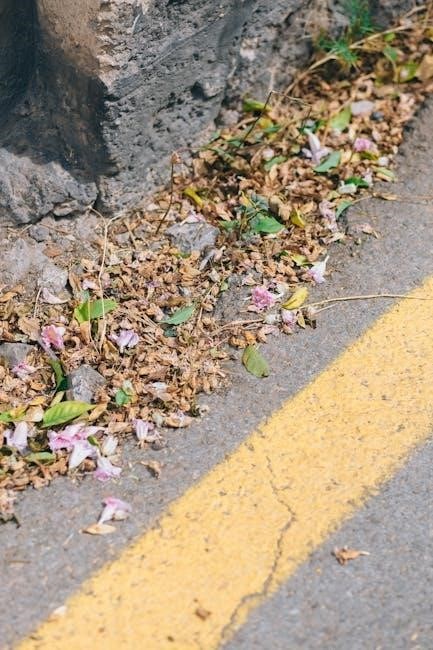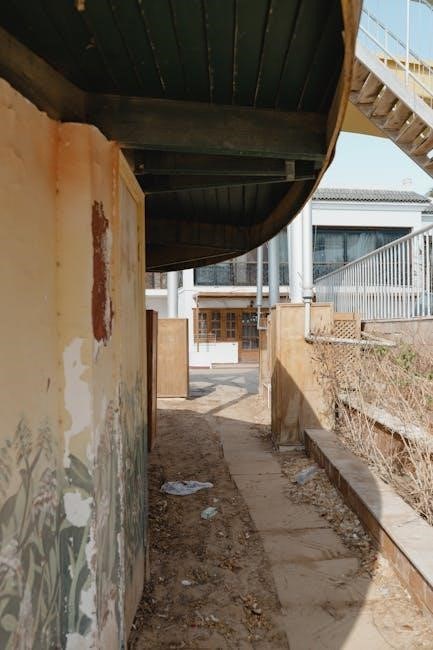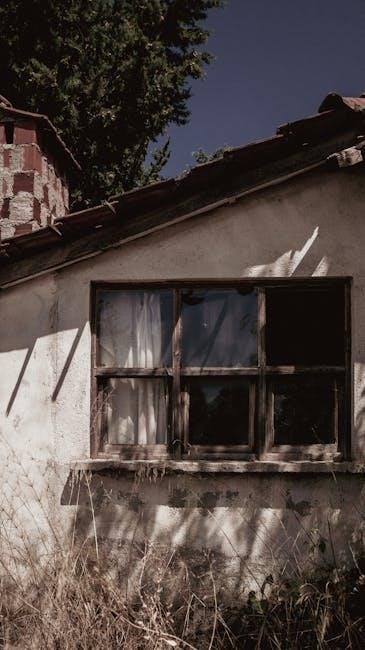Dry pour concrete is a cost-effective method for creating pathways‚ driveways‚ and slabs. It involves pouring dry concrete mix into forms‚ then adding water on-site. This technique offers efficiency and durability for various projects.
What is Dry Pour Concrete?
Dry pour concrete is a construction method where dry concrete mix is placed into forms without pre-mixing with water. It is then hydrated on-site by gradually adding water‚ ensuring proper bonding and strength. This technique differs from traditional wet pouring‚ as it avoids premixing‚ reducing waste and labor. The dry mix‚ typically a combination of cement‚ sand‚ and aggregate‚ is screeded and leveled once water is added. It’s often used for pathways‚ driveways‚ and slabs due to its cost-effectiveness and ease of application. The process allows for better control over moisture levels‚ promoting even curing and durability. Dry pour concrete is particularly popular for projects where traditional mixing equipment isn’t accessible‚ offering a practical alternative for DIY and small-scale projects.
Advantages of Dry Pour Concrete
Dry pour concrete offers several advantages‚ making it a preferred choice for many projects. It eliminates the need for premixing‚ reducing equipment requirements and labor costs. The dry mix can be stored for later use‚ minimizing waste. This method allows precise control over water addition‚ ensuring optimal hydration and strength. It’s ideal for remote locations where mixing facilities are unavailable. Dry pour concrete dries faster than traditional methods‚ enabling quick access to finished surfaces. It’s also environmentally friendly‚ as it reduces water usage and potential runoff. Additionally‚ it’s suitable for various applications‚ including pathways‚ driveways‚ and slabs‚ providing a durable and long-lasting result with minimal maintenance.
Preparation for Dry Pour Concrete

Preparation involves ensuring the surface is clean‚ dry‚ and structurally sound. Forms must be properly set up‚ and all materials should be ready for efficient pouring.
Surface Preparation
Surface preparation is crucial for dry pour concrete success. Ensure the area is clean‚ dry‚ and free from dirt‚ oil‚ or old materials. Remove any debris and vegetation. Lightly tamp the ground to create a stable base. Check for levelness using a spirit level and make adjustments as needed. For existing surfaces‚ high-pressure washing is recommended to eliminate stains and prevent moss growth. This step ensures proper adhesion and a smooth finish for the concrete. Proper preparation prevents issues like uneven settling or poor bonding‚ ensuring a durable and long-lasting result. A well-prepared surface is the foundation of a successful dry pour concrete project.
Mixing Ratios and Materials
Mixing ratios and materials are key to dry pour concrete success. Typically‚ a 6:1 ratio of sand to cement is recommended‚ with adjustments for soil conditions. For boggy soil‚ increase the cement proportion for stability. Use high-quality materials like Sakrete Concrete Mix or Sakrete Fast Set for optimal results. Lightweight concrete may require specialized mixes. Ensure all materials are dry before combining to prevent premature hydration. Regular concrete bags may need additional aggregates for strength. Proper gradation of sand and cement ensures drainage and durability. Follow manufacturer guidelines for specific products. Accurate mixing ratios prevent structural weaknesses. Always test small batches to verify consistency before large-scale application. This step ensures the concrete sets properly and meets project requirements. Correct material selection and mixing are vital for long-lasting results.
Setting Up Forms
Setting up forms is a critical step in dry pour concrete projects. Use sturdy materials like 2×6 lumber to create the desired shape. Ensure forms are level and secure with stakes to prevent shifting. Seal any gaps with silicone or form tape to avoid concrete leakage. Align edges precisely for a professional finish. Use a spirit level to verify accuracy. Double-check measurements and alignment to ensure proper fit. Proper form setup ensures the concrete slab will have the correct dimensions and finish. Avoid over-tightening‚ which can distort the forms. Make sure forms are clean and dry before pouring. This step sets the foundation for a successful dry pour concrete application. Properly set forms lead to a durable and visually appealing final product. Attention to detail here prevents costly corrections later.
Pouring and Finishing the Concrete

Pour the dry concrete mix into the prepared forms‚ then gradually add water‚ starting at one corner and working across the slab. Use a screed board to level the surface‚ ensuring even distribution. Finish with edging tools to create smooth edges and a uniform appearance. This method allows for efficient and precise placement of the concrete‚ ensuring a professional-grade finish. Proper techniques during pouring and finishing are essential for achieving a durable and visually appealing result.
Techniques for Pouring Dry Concrete
Pouring dry concrete requires careful preparation and execution. Start by filling the prepared forms with the dry concrete mix‚ ensuring even distribution. Gradually add water to the mix‚ beginning at one corner and working across the slab to avoid uneven hydration. Use a spirit level or screed board to spread and level the concrete‚ ensuring proper compaction. Work in sections to maintain control and prevent the material from setting too quickly; Avoid overwatering‚ as this can weaken the structure. Use edging tools to smooth the edges and create a clean finish. Proper techniques ensure a strong‚ durable‚ and visually appealing surface. This method is ideal for pathways‚ driveways‚ and other outdoor projects.
Screeding and Leveling
Screeding and leveling are crucial steps in achieving a smooth and even surface when using dry pour concrete. Use a screed board or straightedge to spread the concrete mixture evenly across the form. Start from one end and work systematically to the other‚ ensuring the material fills the form completely. Use a sawing motion to remove excess concrete and fill low spots. A spirit level can help verify that the surface is perfectly horizontal. Repeat the process until the entire area is level and free from air pockets. Proper screeding ensures a professional finish and prevents uneven settling. This step requires patience and attention to detail to achieve optimal results. A well-leveled surface is essential for both functionality and aesthetics.
Edging and Smoothing
Edging and smoothing are the final touches after screeding‚ ensuring a professional finish. Use a concrete edger or a specialized tool to round the edges‚ preventing chipping and creating a clean look. For smoothing‚ employ a trowel or float to eliminate minor imperfections. Work in sections‚ applying light pressure to avoid pushing material out of the form. A dampened trowel can help achieve a high-gloss finish. Regularly inspect the surface to address any marks or unevenness. Proper edging and smoothing enhance durability and aesthetics‚ making the concrete slab more resistant to wear and tear. These steps require precision and care to ensure a flawless outcome‚ completing the transformation from raw mix to a polished‚ long-lasting surface.

Curing and Drying
Curing and drying are critical for strength and durability. Keep the concrete moist for at least 90 days‚ ideally under a misting system or wet covers. Proper hydration ensures a strong structure and prevents cracks. Avoid direct sunlight and heavy traffic during this period. Regular inspection ensures optimal conditions for curing‚ leading to a long-lasting‚ high-quality finish.
Initial Curing Steps
The initial curing steps for dry pour concrete are crucial for proper hydration and strength development. After pouring and finishing‚ mist the surface with water every 10-15 minutes for the first 24-48 hours to prevent premature drying. Apply a layer of wet burlap or a concrete curing blanket to maintain consistent moisture levels; Avoid direct sunlight during this period‚ as it can cause uneven drying. For the first week‚ ensure the surface remains damp‚ either through regular misting or a fogging system. This initial phase ensures the concrete sets properly and develops its structural integrity. Avoid allowing foot or vehicle traffic on the surface until the curing process is complete‚ typically after 7-14 days‚ depending on environmental conditions.
Maintaining Moisture
Maintaining moisture is essential for the proper curing of dry pour concrete. After the initial curing steps‚ continue to mist the surface lightly but thoroughly several times a day‚ ensuring no standing water forms. Covering the slab with plastic sheeting or a specialized curing membrane can help retain moisture and regulate evaporation. Avoid overwatering‚ as this can weaken the concrete. In hot or windy conditions‚ increase the frequency of misting to counteract rapid moisture loss. Proper hydration during the curing phase ensures the concrete achieves its full strength and durability‚ making it resistant to cracking and wear over time. Consistent moisture levels are critical for the first few weeks to allow the cement to hydrate fully and bond with the aggregates effectively.

Drying Timeline
The drying timeline for dry pour concrete varies based on environmental conditions; Typically‚ the surface sets within 24-48 hours‚ allowing light foot traffic. Full curing takes about 28 days‚ but the concrete may be ready for light use within 7-10 days. Heavy traffic or vehicle use should be avoided for at least 90 days to ensure maximum strength. Moisture levels‚ temperature‚ and humidity significantly impact the drying process. In hot‚ dry weather‚ the surface may harden quickly‚ while cooler‚ humid conditions slow down curing. Proper maintenance during this period is crucial to achieve optimal results. Allow the concrete to cure naturally without applying sealers or finishes until it has fully dried and hardened.
